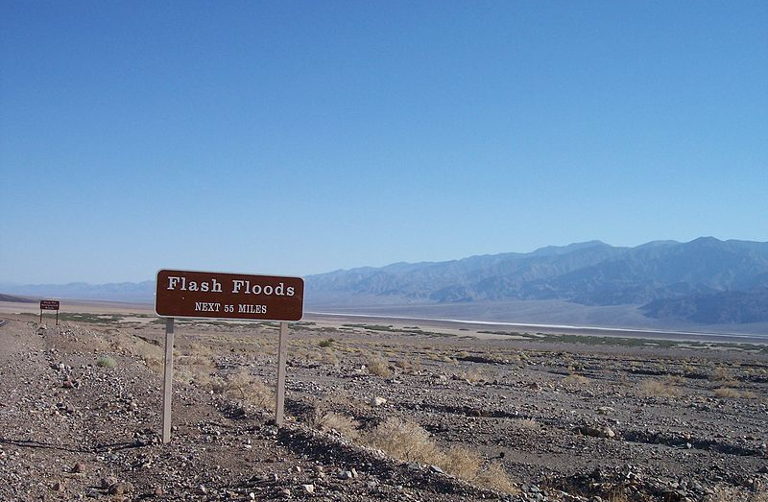I visited Death Valley in August 2008 shortly after rare, plentiful rains (at least by Death Valley standards) had turned one of the Earth’s hottest and driest places into a riot of yellow, blue, red and pink color as wildflowers bloomed across the valley. The day I visited was a clear one and not at all unusual for Death Valley at that time of year. When at midday we tourists climbed off the air-conditioned bus, it felt as if I had just stepped into a pre-heated oven. It was 112 degrees F.
I had no thoughts of climate change that day. This was just the way Death Valley was and had been for a very long time. However, reading about recent heavy rains in Death Valley twice in the last week—rains so heavy that they trapped automobiles and closed roads due to mud and debris—I took note that in a place where dryness and heat are normal, water suddenly became a dangerous hazard, one that resulted in the closing of all roads in and out of the national park that comprises Death Valley. (Something similar happened in nearby Las Vegas, Nevada the week before as water flooded streets and gushed through roofs flooding casinos and frightening visitors. This in a city that gets less than 5 inches of rain a year.)
Drought has been getting almost all the media coverage in the American Southwest. That’s in part because the drought story persists over long periods and becomes a story whenever fear of water restrictions or actual restrictions surface or when it looks like rain might bring relief.
Floods, however, come and go. But they are just as much a part of the perturbation and intensification of the hydrological cycle.
Just as climate models predicted, rains are becoming more frequent and more intense as the hydrological cycle speeds up due to greater evaporation resulting from warmer temperatures across the Earth. Simply put, a warmer atmosphere can hold more water vapor and that means there is more available for rain. But the strange result is that dry areas will tend to get drier while many wet areas may experience even more precipitation. That’s a generalized expectation that varies according to specific circumstances. And, of course, recently we can see how devastating rains in dry places NOT built to handle such a large amount of water can be.
These recent heavy rains will do little to relieve the ongoing megadrought in the American Southwest. Some 22 years of less than normal rain is difficult to reverse in a short period. I first covered this drought when it was in its 10th year. It seemed dire to me then, but did not appear to arouse much worry among the residents of Las Vegas at the time as my title, “The show must go on,” indicated.
There is a little more alarm now as mandated reductions in delivery of Colorado River water to the states along its banks have taken place and must now be deepened. Sometime this month how the new and increasing pain of reductions will be spread among those served by the Colorado will be announced.
Death Valley is looking more and more like the future of the American Southwest, hotter, drier and punctuated by an occasional catastrophic rainfall that nevertheless fails to make much of a dent in the long drought.
Do those living inside the drought boundary generally understand the trajectory they are on? Does the outside world? It’s hard to answer the first question. But the second one may be easier. In the 22nd year of the drought, more people moved to Arizona than left it. More people moved to Utah than left as well. As of 2019, Nevada was still attracting new people from around the country. Only California has been losing population over the last two years.
Why people move is a complex question to answer. Increasingly, I believe, one answer will be water, both for those leaving these states and for those considering a move to these states but who end up choosing to move elsewhere rather than take their chances on increasing water restrictions as the area’s megadrought continues to bear down on its residents.
Photo: Death Valley National Park. National Park Service sign warns of flash floods over a vast area (2004). By Draxfelton. Via Wikimedia Commons https://commons.wikimedia.org/wiki/File:Death_Valley_flash_flood_warning_sign.jpg






